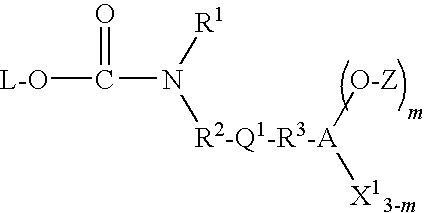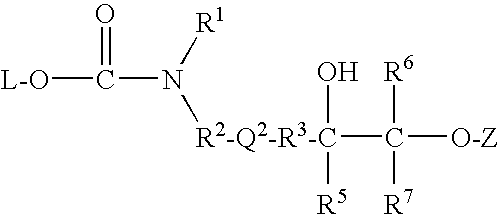Covalently bound polysaccharide-based chiral stationary phases and method for their preparation
a chiral stationary phase, covalently bound polysaccharide technology, applied in the direction of solid sorbent liquid separation, sugar derivates, separation processes, etc., can solve the problem of adverse effect of chiral recognition ability
- Summary
- Abstract
- Description
- Claims
- Application Information
AI Technical Summary
Benefits of technology
Problems solved by technology
Method used
Image
Examples
example 1
Synthesis of Carbamate-Derivatized Celluloses
[0083]Isocyanate modified cellulose (carbamate-derivatized cellulose) was prepared according to a modified literature method using a phenyl isocyanate to derivatize the cellulose. In this embodiment, powder of microcrystalline cellulose (10.0 g, 61.7 mmol sugar repeat unit) was suspended in pyridine (200 mL) and the flask was purged with nitrogen for 15 min at room temperature. 3,5-dimethylphenyl isocyanate (30.0 mL, 210 mmol) was added to the suspension via syringe. The solution was stirred at 90-100° C. under a nitrogen atmosphere for 12 hr. The starting cellulose is insoluble in reaction media, and it was gradually dissolved into pyridine to form a clear light-yellow viscous solution as the reaction proceeded under heating. The viscous solution was then precipitated into methanol, and the filtered precipitate was redissolved in acetone, and reprecipitated in methanol to give 30.0 g (91% yield) of tris(3,5-dimethylphenylcarbamate) cellu...
example 2
Synthesis of Vinyl Functionalized Carbamate-Derivatized Celluloses
[0084]To a solution of tris(3,5-dimethylphenylcarbamate) cellulose (I, 15.0 g, 25.0 mmol of sugar unit or 75.0 mmol of carbamate) in DMF (120 mL), NaH (60% in mineral oil, 0.1 g, 2.5 mmol) was added at ambient temperature. After 60 min, 10-bromo-1-decene (165 mg, 0.75 mmol) in 30 mL of DMF was added via syringe, stirred at room temperature for 12 hr. The pH of the solution was adjusted to 5 using 6M HCl and the solution was precipitated in a 20:1 mixture of methanol:hexane. The filtered solid was dissolved in acetone and reprecipitated in methanol to give 14.1 g (94% yield) of vinyl functionalized carbamate-derivatized celluloses (II). Ca. 1 mol % of vinyl functionality (relative to carbamate functionality) was grafted, which was quantified by 1H NMR spectroscopy.
example 3
Synthesis of Alkoxysilane Functionalized Carbamate-Derivatized Celluloses
[0085]To a solution of vinyl functionalized carbamate-derivatized celluloses (II, 7.2 g, 0.36 mmol of vinyl functionality) in THF (100 mL), HSi(OC2H5)3 (73.8 mg, 0.45 mmol), and chloroplatinic acid (H2PtCl6.6H2O, 9.3 mg, 5 mol %) were added at ambient temperature. The reaction mixture was stirred at 40° C. for 6 hr and then concentrated to afford alkoxysilane functionalized carbamate-derivatized celluloses (III).
PUM
| Property | Measurement | Unit |
|---|---|---|
| Temperature | aaaaa | aaaaa |
| Temperature | aaaaa | aaaaa |
| Temperature | aaaaa | aaaaa |
Abstract
Description
Claims
Application Information
 Login to View More
Login to View More - R&D
- Intellectual Property
- Life Sciences
- Materials
- Tech Scout
- Unparalleled Data Quality
- Higher Quality Content
- 60% Fewer Hallucinations
Browse by: Latest US Patents, China's latest patents, Technical Efficacy Thesaurus, Application Domain, Technology Topic, Popular Technical Reports.
© 2025 PatSnap. All rights reserved.Legal|Privacy policy|Modern Slavery Act Transparency Statement|Sitemap|About US| Contact US: help@patsnap.com



